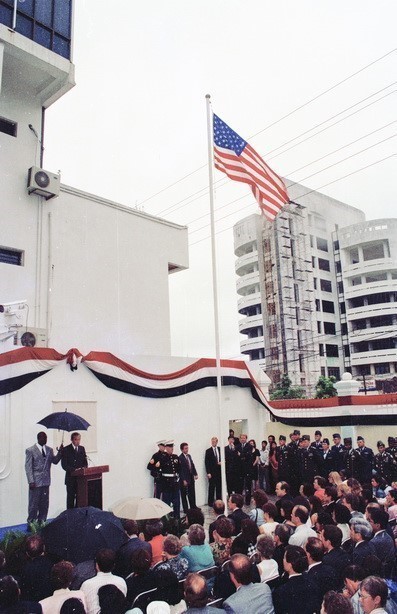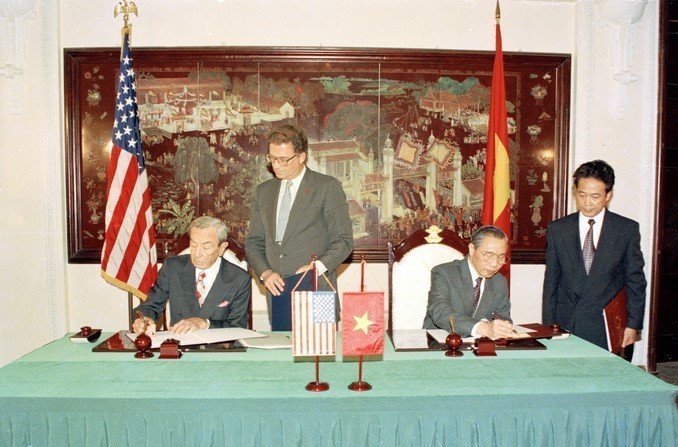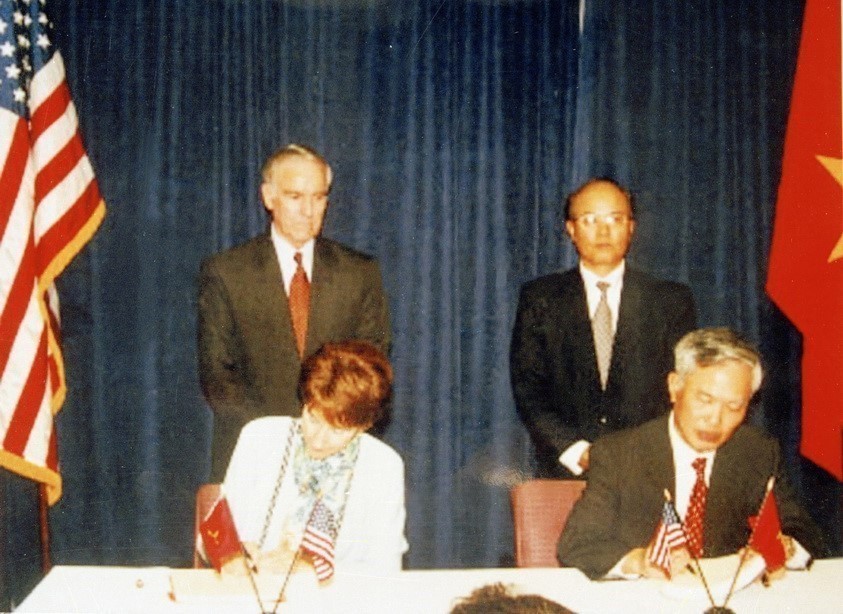Hanoi (VNA) – On the night of July 11, 1995 (July 12, 1995 in Vietnam time), US President William J. Clinton announced the normalisation of relations with Vietnam. Only hours later, Vietnamese Prime Minister Vo Van Kiet read out a statement on the normalisation.
Since then, the two countries have successfully turned from former foes to friends and comprehensive partners in all fields, from politics-diplomacy, economy, education and science-technology to defence-security, with increasingly reinforced momentum and expanded scope of substantive and effective cooperation.
Political-diplomatic ties promoted with important landmarks
After the two countries declared the normalisation of bilateral ties and the establishment of diplomatic relations, US Secretary of State Warren Christopher and Vietnamese Foreign Minister Nguyen Manh Cam signed a protocol in Hanoi on August 5, 1995, officially setting up diplomatic relations between the two sides.
Shortly after that, Vietnam and the US opened their embassies in Washington DC and Hanoi in August 1995.
In November 2000, President William J. Clinton visited Vietnam, becoming the first US leader to pay an official trip to the Southeast Asian nation. He was seen as a person with great contributions to the normalisation of the countries’ relations, both while serving as President and after leaving office.
The approval of the Vietnam-US Joint Vision Statement shows the straightforwardness and openness between the two countries’ leaders in discussing issues previously considered sensitive.
In June 2005, Prime Minister Phan Van Khai visited the US at the invitation of President George W. Bush, marking the first time a Prime Minister of Vietnam to have come to the North American nation after the end of the war.
During this tour, the two sides inked an agreement on economic and technical cooperation, along with others on intelligence and military cooperation. The Vietnamese Prime Minister, along with more than 100 representatives of the public and private sectors, also visited three other cities where many major business contracts were signed.

In November 2006, US President George W. Bush made a four-day trip to Vietnam within the framework of the Asia-Pacific Economic Cooperation (APEC) Leaders’ Meeting.
At that time, President Bush and Secretary of State Condoleezza Rice visited Hanoi and Ho Chi Minh City. Trade Representative Susan Schwab attended an APEC ministers’ meeting, bilateral meetings and other events in Hanoi from November 15 to 18.
In June 2007, Vietnamese President Nguyen Minh Triet paid an official visit to the US at the invitation of President George W. Bush. The two leaders met to talk about economic and trade connections. Meanwhile, Deputy Minister of Trade Nguyen Cam Tu and Deputy Trade Representative Karan Bhatia signed the Trade and Investment Framework Agreement (TIFA) on June 21.

In June 2008, Prime Minister Nguyen Tan Dung came to the US at the invitation of President George W. Bush. At meetings with senior officials of the US, including speakers of the Senate and the House of Representatives, the Secretary of Defence and the Secretary of the Treasury, the Government leader of Vietnam received positive signals in the promotion of bilateral ties in all aspects, especially economy, trade, investment and education. This visit’s outcomes marked a new milestone in their relations.
In July 2013, another visit to the US by a Vietnamese leader, President Truong Tan Sang, was made at the invitation of President Barack Obama. The biggest outcome of this trip was the establishment of the Vietnam-US comprehensive partnership, shaping the framework for bilateral connections in the new period as well as orientations for their relations in the subsequent years.

In July 2015, when the two countries were celebrating 20 years since the normalisation of relations, Party General Secretary Nguyen Phu Trong paid an official visit to the North American nation. Following the two leaders’ talks, the Vietnam-US Joint Vision Statement was issued, showing the straightforwardness and openness between the Vietnamese and US leaders in discussing issues previously described as sensitive. It was expected to help the countries’ relations become more substantive in the future when cooperation aspects will no longer be hampered by differences.
The Vietnam-US Joint Vision Statement reads that the good and full implementation, along with the unceasing intensification and diversification of the comprehensive partnership on the basis of respect for each other’s independence, sovereignty and political regimes and non-intervention in each other’s internal affairs, provides the foundation for building trust and developing bilateral ties to a new level.
In the official visit to Vietnam in May 2016, President Barack Obama held talks with his Vietnamese counterpart Tran Dai Quang in Hanoi, announcing the important decision to lift the lethal arms trade ban on Vietnam. The joint statement issued following the talks also featured many commitments to enhancing cooperation in all spheres. A number of important documents and large project agreements were also inked.
That visit was seen as a new landmark in bilateral relations. With the lethal arms trade ban fully lifted, the last obstacle in Vietnam-US relations was removed, marking the complete normalisation of their ties and sending out a meaningful message about the enhancement of the strategic trust and the comprehensive partnership. The trip was described as a demonstration of a long stride in US leaders’ mindset towards Vietnam.

The official visit to the US in May 2017 by Prime Minister Nguyen Xuan Phuc at the invitation of President Donald Trump was seen as opening up a new chapter in the Vietnam-US comprehensive partnership. During the visit, the two sides pledged to bolster the upward trend of their relations and also reached a common perception on a new framework for the partnership in the coming time, thus creating new driving forces for their partnership and contributing to regional and global peace and prosperity.
In November 2017, President Donald Trump paid a state visit to Vietnam and attended the APEC Leaders’ Meeting from November 11 to 12.
In the joint statement issued in this visit, both sides agreed to continue strengthening the comprehensive partnership on the basis of respecting each other’s independence, sovereignty, territorial integrity and political regime.
For his part, President Donald Trump took part in the second summit between the US and the Democratic People’s Republic of Korea held in Hanoi in February 2019. During the stay, he also had meetings with Vietnamese leaders.

On this occasion, Party General Secretary and State President Nguyen Phu Trong and President Donald Trump witnessed the singing of four cooperation documents relating to the aviation sector with the total value of about 21 billion USD.
Over the last 25 years, the two countries have also exchanged mutual visits at all levels, including the trips to the US by Deputy Prime Minister and Foreign Minister Pham Binh Minh and Defence Minister Ngo Xuan Lich, and the tours of Vietnam by Defence Secretary James Mattis and State Secretary Mike Pompeo.
During the term of President Donald Trump, relations between the two countries have been generally developing well. High-level visits by their leaders have helped intensify the comprehensive partnership.
Regarding the issues of democracy and human rights, both sides have continued straightforward and constructive dialogues on differences so as not to let those problems negatively affect other cooperation aspects.
In terms of multilateral aspects, Vietnam and the US have reinforced collaboration and coordinated well with each other at international and regional forums, worked together on global agenda, promoted the role of ASEAN, and tightened ASEAN-US connections.

Breakthrough growth in economic-trade links
Apart from sound political links, economic and trade relations are also considered one of the most successful fields of bilateral cooperation and becoming a driving force for the overall relationship between the two countries.
The US is currently the third-largest among the more than 100 trade partners of Vietnam around the globe.
Vietnam and the US are complementary to each other in economic and trade links.
In return, the Southeast Asian country ranks 16th among the trade partners of the North American nation. Bilateral trade has grown by 20 percent annually, with Vietnam continuously recording surplus with the US.
Trade between the two countries has surged by almost 120 times, from 451 million USD in 1995 to 7.8 billion USD in 2005, 45.1 billion USD in 2015, 47.15 billion USD in 2016, 50.8 billion USD in 2017, and 60.3 billion USD in 2018.
Their trade turnover reached 77.5 billion USD in 2019, which was forecast to hit 80 billion USD this year by the American Chamber of Commerce (AmCham).
According to Deputy Minister of Industry and Trade Do Thang Hai, Vietnam and the US are complementary to each other in economic and trade links.
The US has big demand for typical farm produce or products that Vietnam has strength in like apparel, footwear, wood products, machinery and electronic devices. Meanwhile, Vietnam also needs machinery, hi-tech devices, aviation and telecoms equipment and raw farm produce that the US has abundant supply.
In terms of investment, by the end of 2019, the US ranked 11th among the 130 countries and territories directly investing in Vietnam, with nearly 1,000 valid projects worth approximately 10 billion USD at present, data of the Ministry of Planning and Investment show.
Having yet to rank among the top foreign investors in Vietnam, the US is still assessed as a high-quality investor. Running many valuable projects, US businesses have been actively cooperating with and assisting their local partners to develop while contributing considerably to social activities.
The North American country is also an investment recipient of Vietnamese enterprises. It stood at the second place among overseas destinations of Vietnamese investment between January and May this year, with 21.72 million USD or nearly 12 percent of the latter’s total overseas investment.

Defence-security cooperation – Impressive changes made
Defence-security ties between Vietnam and the US were formed right when their relations were normalised in 1995, and cooperation in this regard has undergone impressive changes.
While the countries initially just held bilateral meetings with a focus on the prisoner of war/missing in action (POW/MIA) in the war in Vietnam, they later began organising mutual visits by defence ministers and have enjoyed substantive strides in the settlement of war aftermaths and other issues.

In June 2015, the two countries’ defence ministers signed the Vietnam-US Joint Vision Statement on Defence Relations.
Particularly, during his official trip to Vietnam on May 23, 2016, President Barack Obama announced the complete lifting of the US’ embargo on the sale of lethal weapons to Vietnam, a meaningful stride to foster the comprehensive partnership, helping to consolidate mutual trust for stronger cooperation to effectively respond to regional security threats.
Collaboration has also been expanded to military medicine training, humanitarian aid, disaster relief, peacekeeping, information sharing, improvement of counter-terrorism capacity, cyber security, and water resources security. The US has actively assisted Vietnam to address war consequences and improve the capacity of Vietnamese coast guards and navy, and supported Vietnam’s peacekeeping force.
So far, the two sides have organised more than 4,000 joint searches which found and returned to the US the remains of 1,000 servicemen missing in action. They are also keeping joint efforts to search for about 200,000 Vietnamese soldiers missing in action.
Additionally, the Southeast Asian country welcomed US aircraft carriers twice, in March 2018 and March 2020.
They are currently maintaining all-level delegation exchanges, bilateral dialogue mechanisms and meetings at regional forums.
Vietnam, the US and other nations are also working together to maintain navigation freedom and exercise the 1982 UN Convention on the Law of the Sea (UNCLOS) in the East Sea. Both support the viewpoint that the freedom and security of navigation and overflight must be guaranteed, international law and UNCLOS respected, disputes resolved via diplomatic and legal processes without use or threat to use force, and actions escalating tensions in the region avoided.
Together with many other regional countries, Vietnam has been cooperating closely with the US to carry out UN resolutions relevant to the issue of the Democratic People’s Republic of Korea.
The two sides also approved the three-year plan of action for defence cooperation for 2018-2021.

Multiple opportunities for scientific-technological cooperation
In 2000, the countries signed an agreement on scientific-technological cooperation and established a joint committee for scientific-technological cooperation. Meanwhile, the Agreement for Cooperation Concerning Peaceful Uses of Nuclear Energy was inked on May 6, 2014, opening up considerable chances for bilateral partnership in the area of civil nuclear energy.
Meanwhile, Vietnam and the US have also begun working together on outer space when the US National Aeronautics and Space Administration (NASA) and the Vietnam Academy of Science and Technology (VAST) signed a statement of joint intent on cooperation in space exploration in December 2011.
Later, the VAST and the US Agency for International Development (USAID) inked a statement on scientific-technological cooperation in March 2015 and an administrative arrangement under the Agreement for Cooperation Concerning Peaceful Uses of Nuclear Energy in May 2016.
The two sides held the first dialogue on energy security in Hanoi in March 2018 and the second in Washington DC in April 2019.
Connections in culture, education, environment prove fruitful
Education-training cooperation is also an important factor in bilateral ties.
There are more than 3,000 Vietnamese students and interns in the US at present, making Vietnam the largest in Southeast Asia and the sixth in the world in terms of the number of foreign students in the US.
In 2017, the countries opened the Fulbright University Vietnam, facilitating Vietnamese youth to access high-quality education. Every year, the US also grants scholarships for post-graduates of Vietnam under scholarships programmes like Fulbright and the Vietnam Education Foundation.

They have also cooperated actively under the deal on the implementation of the Peace Corps programme, allowing US volunteers to teach English in Hanoi and Ho Chi Minh City.
Besides, the US has continued to pay attention to medical, environmental and humanitarian cooperation with Vietnam.
It has maintained and increased funding for the settlement of war consequences in Vietnam, including the detoxification of dioxin contamination hotspots and support for Agent Orange/dioxin victims.
In 2017, the US basically completed the dioxin cleanup at Da Nang Airport and pledged to continue the remediation at Bien Hoa Airport. The country has also sponsored projects on addressing consequences of war-left unexploded ordnance in Vietnam with the total funding amounting to 94 million USD via non-governmental organisations since 1993.
With regard to tourism, 687,200 visitors from the US traveled to Vietnam in 2018, rising 11.9 percent year on year and accounting for 4.4 percent of the total foreign arrivals in the latter.
US visitors to Vietnam make up about 11 percent of all the US travelers to the whole Asia. Many famous websites, magazines and TV channels have also honoured destinations in Vietnam.
Over the last two and a half decades, the two countries have coordinated closely in multiple spheres at bilateral, regional and global levels. That development matches the trend of the era, thereby generating benefits for the two peoples, as well as peace, friendship, cooperation and development in the region and the world./.
